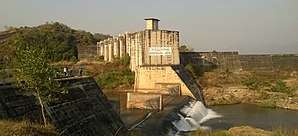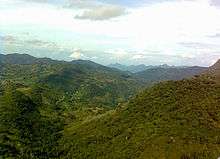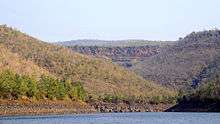Nagavali River
The River Nagavali also known as Langulya is one of the main rivers of Southern Odisha and Northern Andhra Pradesh States in India,[1] between Rushikulya and Godavari basins.
| Nagavali Langulya | |
|---|---|
| Location | |
| Country | India |
| Physical characteristics | |
| Source | Lakhbahal |
| ⁃ location | Kalahandi |
| Length | 256.5 km (159.4 mi)approx. |
| Discharge | |
| ⁃ location | Bay of Bengal |
| ⁃ average | 24 m3/s (850 cu ft/s) |
Origin and course
Nagavali River originates from a hill near Lakhbahal village in Thuamul Rampur block of Kalahandi District. It touches Nakrundi, Kerpai areas of Kalahandi, Kalyansinghpur and Rayagada of Rayagada district of Odisha and merged in Bay of Bengal near Kallepalli village near Srikakulam after crossing by the side of Srikakulam of Andhra Pradesh. It is an independent river with its own basin.
The total length of the river is about 256 kilometres (159 mi), of which 161 kilometres (100 mi) are in Odisha and the rest in Andhra Pradesh. The catchment area of the basin is 9,510 square kilometres (3,670 sq mi). Nagavali is an interstate river with 4,462 square kilometres (1,723 sq mi) and 5,048 square kilometres (1,949 sq mi) river basin area located in Odisha and Andhra Pradesh respectively. The river basin receives 1,000 millimetres (39 in) average rain fall annually. The uplands of the river basin are hilly areas with predominantly tribal populated. It drains parts of the Kalahandi, Rayagada and Koraput districts of Odisha and Srikakulam, Vizianagaram districts of Andhra Pradesh.
Tributaries
The main tributaries of the River Nagavali are Jhanjavati, Barha, Baldiya, Satnala, Sitagurha, Srikona, Gumudugedda, Vottigedda, Suvarnamukhi, Vonigedda, Relligedda and Vegavati. The Suvarnamukhi river takes its birth in the hills of Salur mandal and takes an eastern direction and finally join the Nagavali at Sangam village in Vangara mandal of Srikakulam District. Vegavathi originates in pachipenta hills of Pachipenta Mandal.
- Vegavathi River takes its origin in the Pachipenta hills in Eastern Ghats. It is a tributary to Suvarnamukhi, which in turn is a tributary to River Nagavali. Salur town and Paradhi are located on the banks of this river. There are two road bridges at these places.
Towns and cities
- Rayagada town and district headquarters of Rayagada dist of Odisha, River Nagavali flows in outskirts of the town.
- Srikakulam town, the district headquarters in Andhra Pradesh: River Nagavali flows through Srikakulam town and meets the sea at Kallepalli village, 5 kilometers far from Srikakulam town.
- Hatipathar, near Rayagada: It is a place of great scenic beauty with two waterfalls on the course of River Nagavali. The boulders here appear in a way that look like huge elephants.
Irrigation projects

- Jhanjavati Project 18°51′49″N 83°26′05″E is located at Rajyalaxmipuram village in Komarada mandal of Vizianagaram district on Jhanjavati, a tributary of River Nagavali.[2] It is a rubber dam and first of its kind in Andhra Pradesh and India and the biggest in Asia.[3][4] It is aimed to utilize 4 TMC of available water and to irrigate / stabilize a total ayacut of 24,640 acres (9,970 ha) in Vizianagaram District. It was dedicated to the nation on 1 January 2006 by Chief Minister Y. S. Rajasekhara Reddy. The rubber dam was installed on a concrete plate in technical collaboration with Hydro-Construct of Austria. However, the prior agreement between Odisha and Andhra Pradesh on this project permits to raise the maximum reservoir level submerging Odisha area up to 480 feet (150 m) msl. This dispute is unsettled till now preventing use of the project's full irrigation potential for last 20 years due to present 0.6 tmcft reservoir storage capacity against 4 tmcft planned storage.[5] Andhra Pradesh wants to resolve the issue by constituting Nagavali water dispute tribunal under the Interstate River Water Disputes Act as the dispute is not getting settled by negotiations between the two states.
- Thotapalli Barrage is located at village Thotapalli in Vizianagaram district and presently being upgraded as barrage.[6]
- Madduvalasa Reservoir is located at Madduvalasa village in Vangara mandal of Srikakulam district. It is built across Vegavati and Suvarnamukhi tributaries. The project is started in 1977 and provides water for 24,500 acres (9,900 ha) of land for cultivation.[7]
- Narayanapuram barrage 18°29′07″N 83°48′31″E is located in Burja mandal of Srikakulam district.[8]
- Vamsadhara and Nagavali inter link canal is a 30 km (19 mi) long gravity canal planned to inter link the Vamsadhara and Nagavali Rivers.[9] It will run from Hiramandalam reservoir to Narayanapuram barrage near Amudalavalasa and bring an additional 50,000 acres (20,000 ha) of ayacut under irrigation using 10 tmcft of water from Vamsadhara basin.[10]
See also
References
- "Nagavali.CWC" (PDF). Archived (PDF) from the original on 21 July 2011. Retrieved 12 April 2007.
- "Janjavathi Dam D01971". Archived from the original on 21 August 2016. Retrieved 5 September 2016.
- "The Hindu on Jhanjavati Project". Archived from the original on 1 October 2007. Retrieved 12 April 2007.
- "First rubber dam in Andhra, tackles dispute over Jhanjavati river with Orissa". Archived from the original on 1 October 2016. Retrieved 8 June 2014.
- "Agreements with Odisha on Nagavali river waters sharing - pages 258, 259 & 263" (PDF). Archived from the original (PDF) on 10 November 2011. Retrieved 17 November 2013.
- "Thotapalli Barrage B00429". Archived from the original on 3 October 2016. Retrieved 5 September 2016.
- "Madduvalasa Dam D02113". Archived from the original on 21 August 2016. Retrieved 5 September 2016.
- "Narayanapuram Anicut Medium Irrigation Project JI00114". Archived from the original on 22 February 2016. Retrieved 5 September 2016.
- "AP plans to link Vamsadhara, Nagavali". Archived from the original on 5 September 2016. Retrieved 5 September 2016.
- "Hiramandalam Dam D03520". Archived from the original on 5 September 2016. Retrieved 5 September 2016.
External links
| Wikimedia Commons has media related to Nagavali River. |



